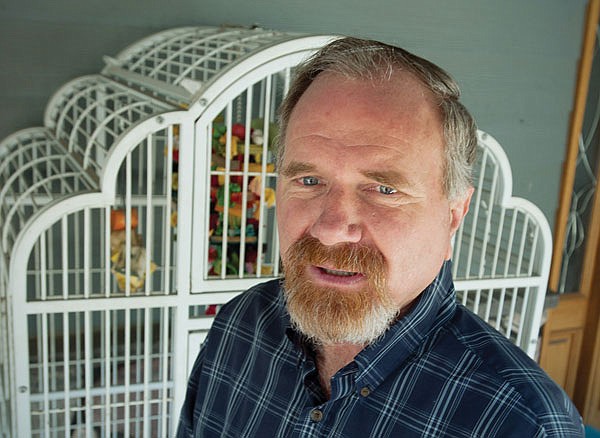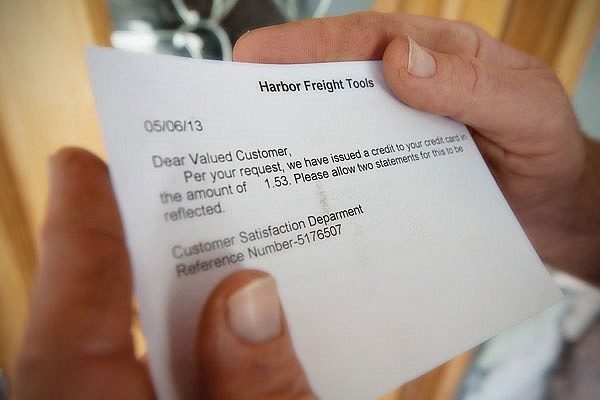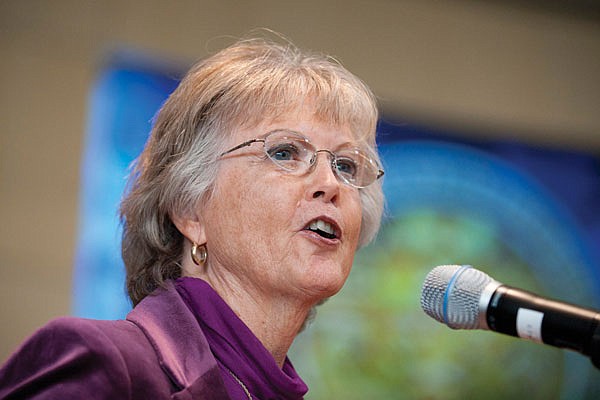 Facebook
Facebook
 X
X
 Instagram
Instagram
 TikTok
TikTok
 Youtube
Youtube

‘I knew there was something totally wrong there,” Crest resident Dave Davies says of a purchase he made online on Tuesday, March 12. “I took a look at the taxes that they charged me, and I multiplied the product times .08, which is our tax rate, and it wasn’t the same amount.”

Davies, who runs a home-based business selling alpacas and processing their wool through his mill, contacted the customer-service department of Harbor Freight Tools, where he’d made the purchase, to alert them to their mistake.
“I told them I live in the unincorporated area of Crest,” he continues. “They looked at their things and said according to their information, I’m in El Cajon, because the zip code’s 92021. He looked at his tax rate from the state and says, ‘Well, in El Cajon, the tax rate is 9 percent, so we charged you correctly, and there’s nothing we can do about it.”
Davies then did his own research and found that Crest was not listed on tax-rate tables under San Diego County or the City of El Cajon. The following day, he sent a letter to Michelle Steel, the vice chair and third district member of the California State Board of Equalization, that read, “I ordered a part today and found that I was over taxed. I am in the unincorporated city of Crest in San Diego County. This city is just like Alpine in San Diego County, which has a tax rate of 8%. I was charged 9%. . . I would like this immediately corrected since I am being over charged. El Cajon city is listed at 9% but I do not reside in El Cajon. My postal code is 92021-4281, which is Crest, CA., not El Cajon. Please correct this injustice immediately. I resent being over taxed.”
On Thursday, March 14, Davies received a response from Larry Micheli, a supervisor in the Local Revenue Allocation Unit. After apologizing for the overtaxation, Micheli wrote, “Unfortunately, the situation you describe has become more common as more cities impose district taxes.... Based on your email, staff have verified that the entire community of Crest is in the unincorporated County of San Diego, so the appropriate tax rate for that community will be included in our on-line publication 71 during its next revision.”
Micheli also asked for verification of Davies’s address and, soon after, emailed and mailed a letter from the board that he suggested Davies use to obtain a refund from Harbor Freight Tools.
Davies responded by asking when the online publication would be revised and whether Harbison County, San Carlos, and San Miguel would be included, as he was also unable to find any of the three unincorporated areas listed on the tables.
Micheli responded, “As requested we have researched the three areas you mentioned and agree that Harbison Canyon and San Miguel (Fire District) are in the unincorporated county. However, San Carlos is within the City of San Diego.... We will revise our on-line publication 71 to reflect the areas described. We just modified it for the 22 new district taxes that will take effect on April 1. However, we have another new district that will become operative on July 1, so when we update the publication for that new district we will recommend the changes that have been previously described.”
The email from Micheli assured him that in the event he did not receive a refund from Harbor Freight Tools, the Board of Equalization would reimburse him.
Davies forwarded the letter to Harbor Freight Tools. After four follow-up calls, he finally received a $1.53 refund on May 6.


Davies says his main concern was not the refund but the fact that the county was losing revenue that was going to the City of El Cajon. The same day he heard back from the Board of Equalization, he also sent an email to San Diego County supervisor Dianne Jacob, alerting her office to the situation. In the email, he explained the story of his online purchase, pasted a copy of the tax-rate table taken directly from the board’s website, and related another story about an in-store purchase he’d made at RCP Block and Brick. Using phrases such as “taxation without representation” and “completely unconstitutional,” he questioned where the additional 1 percent he and other residents of unlisted, unincorporated areas has been going.
“The point of sale is in Santee. I was standing in Santee. The man asked me if I would like the bricks delivered. He asked me where I lived and my postal code said ‘El Cajon’; therefore, he was going to charge me 9 percent tax, and I asked why. He said that El Cajon is demanding that if the product is delivered to El Cajon, then the customer has to pay sales tax of that city. I don’t even live in El Cajon and yet they are demanding a 9 percent sales tax from me. How is the county getting its tax revenue when a county entity selling to a county location is being taxed at an El Cajon tax rate because El Cajon is demanding a higher tax rate even though the person does not live in that city?. . . I will not pay higher taxation when I do not live in the city of El Cajon,” he wrote, concluding, “I would pray that you will take this matter seriously and correct this injustice.”
Jacob’s office responded with an apology that he’d been overcharged and a promise to forward his information to the State Board of Equalization to get it corrected.
“Dianne Jacob missed the entire point,” Davies says. “Lady, I’ve already got that handled. My concern is how do you have any idea that the county is getting paid?”
Our calls to Jacob’s office directed us back to the California State Board of Equalization, whose spokesperson stated, “If the retailer incorrectly reports taxes remitted to the Board of Equalization at El Cajon’s rate, that portion of the revenues collected will be allocated to El Cajon. The customer who was overcharged has two options — either seeking the refund from the seller for the amount above what should have been collected, or requesting a refund from the [Board of Equalization]. Even if that amount has already been remitted to El Cajon, [the Board of Equalization] will process the refund to the overcharged customer and subtract that amount from El Cajon’s next allocation.”
In January 2013, the tax rate for El Cajon rose from 8.75 to 9 percent, and the Board of Equalization spokesperson stated vendor mistakes “happen often when a rate changes,” especially by national retailers who have not yet updated their systems to reflect new rates. The spokesperson did not, however, answer whether it is common for unincorporated areas to be missing from official tax-rate tables altogether.


‘I knew there was something totally wrong there,” Crest resident Dave Davies says of a purchase he made online on Tuesday, March 12. “I took a look at the taxes that they charged me, and I multiplied the product times .08, which is our tax rate, and it wasn’t the same amount.”

Davies, who runs a home-based business selling alpacas and processing their wool through his mill, contacted the customer-service department of Harbor Freight Tools, where he’d made the purchase, to alert them to their mistake.
“I told them I live in the unincorporated area of Crest,” he continues. “They looked at their things and said according to their information, I’m in El Cajon, because the zip code’s 92021. He looked at his tax rate from the state and says, ‘Well, in El Cajon, the tax rate is 9 percent, so we charged you correctly, and there’s nothing we can do about it.”
Davies then did his own research and found that Crest was not listed on tax-rate tables under San Diego County or the City of El Cajon. The following day, he sent a letter to Michelle Steel, the vice chair and third district member of the California State Board of Equalization, that read, “I ordered a part today and found that I was over taxed. I am in the unincorporated city of Crest in San Diego County. This city is just like Alpine in San Diego County, which has a tax rate of 8%. I was charged 9%. . . I would like this immediately corrected since I am being over charged. El Cajon city is listed at 9% but I do not reside in El Cajon. My postal code is 92021-4281, which is Crest, CA., not El Cajon. Please correct this injustice immediately. I resent being over taxed.”
On Thursday, March 14, Davies received a response from Larry Micheli, a supervisor in the Local Revenue Allocation Unit. After apologizing for the overtaxation, Micheli wrote, “Unfortunately, the situation you describe has become more common as more cities impose district taxes.... Based on your email, staff have verified that the entire community of Crest is in the unincorporated County of San Diego, so the appropriate tax rate for that community will be included in our on-line publication 71 during its next revision.”
Micheli also asked for verification of Davies’s address and, soon after, emailed and mailed a letter from the board that he suggested Davies use to obtain a refund from Harbor Freight Tools.
Davies responded by asking when the online publication would be revised and whether Harbison County, San Carlos, and San Miguel would be included, as he was also unable to find any of the three unincorporated areas listed on the tables.
Micheli responded, “As requested we have researched the three areas you mentioned and agree that Harbison Canyon and San Miguel (Fire District) are in the unincorporated county. However, San Carlos is within the City of San Diego.... We will revise our on-line publication 71 to reflect the areas described. We just modified it for the 22 new district taxes that will take effect on April 1. However, we have another new district that will become operative on July 1, so when we update the publication for that new district we will recommend the changes that have been previously described.”
The email from Micheli assured him that in the event he did not receive a refund from Harbor Freight Tools, the Board of Equalization would reimburse him.
Davies forwarded the letter to Harbor Freight Tools. After four follow-up calls, he finally received a $1.53 refund on May 6.


Davies says his main concern was not the refund but the fact that the county was losing revenue that was going to the City of El Cajon. The same day he heard back from the Board of Equalization, he also sent an email to San Diego County supervisor Dianne Jacob, alerting her office to the situation. In the email, he explained the story of his online purchase, pasted a copy of the tax-rate table taken directly from the board’s website, and related another story about an in-store purchase he’d made at RCP Block and Brick. Using phrases such as “taxation without representation” and “completely unconstitutional,” he questioned where the additional 1 percent he and other residents of unlisted, unincorporated areas has been going.
“The point of sale is in Santee. I was standing in Santee. The man asked me if I would like the bricks delivered. He asked me where I lived and my postal code said ‘El Cajon’; therefore, he was going to charge me 9 percent tax, and I asked why. He said that El Cajon is demanding that if the product is delivered to El Cajon, then the customer has to pay sales tax of that city. I don’t even live in El Cajon and yet they are demanding a 9 percent sales tax from me. How is the county getting its tax revenue when a county entity selling to a county location is being taxed at an El Cajon tax rate because El Cajon is demanding a higher tax rate even though the person does not live in that city?. . . I will not pay higher taxation when I do not live in the city of El Cajon,” he wrote, concluding, “I would pray that you will take this matter seriously and correct this injustice.”
Jacob’s office responded with an apology that he’d been overcharged and a promise to forward his information to the State Board of Equalization to get it corrected.
“Dianne Jacob missed the entire point,” Davies says. “Lady, I’ve already got that handled. My concern is how do you have any idea that the county is getting paid?”
Our calls to Jacob’s office directed us back to the California State Board of Equalization, whose spokesperson stated, “If the retailer incorrectly reports taxes remitted to the Board of Equalization at El Cajon’s rate, that portion of the revenues collected will be allocated to El Cajon. The customer who was overcharged has two options — either seeking the refund from the seller for the amount above what should have been collected, or requesting a refund from the [Board of Equalization]. Even if that amount has already been remitted to El Cajon, [the Board of Equalization] will process the refund to the overcharged customer and subtract that amount from El Cajon’s next allocation.”
In January 2013, the tax rate for El Cajon rose from 8.75 to 9 percent, and the Board of Equalization spokesperson stated vendor mistakes “happen often when a rate changes,” especially by national retailers who have not yet updated their systems to reflect new rates. The spokesperson did not, however, answer whether it is common for unincorporated areas to be missing from official tax-rate tables altogether.
Comments